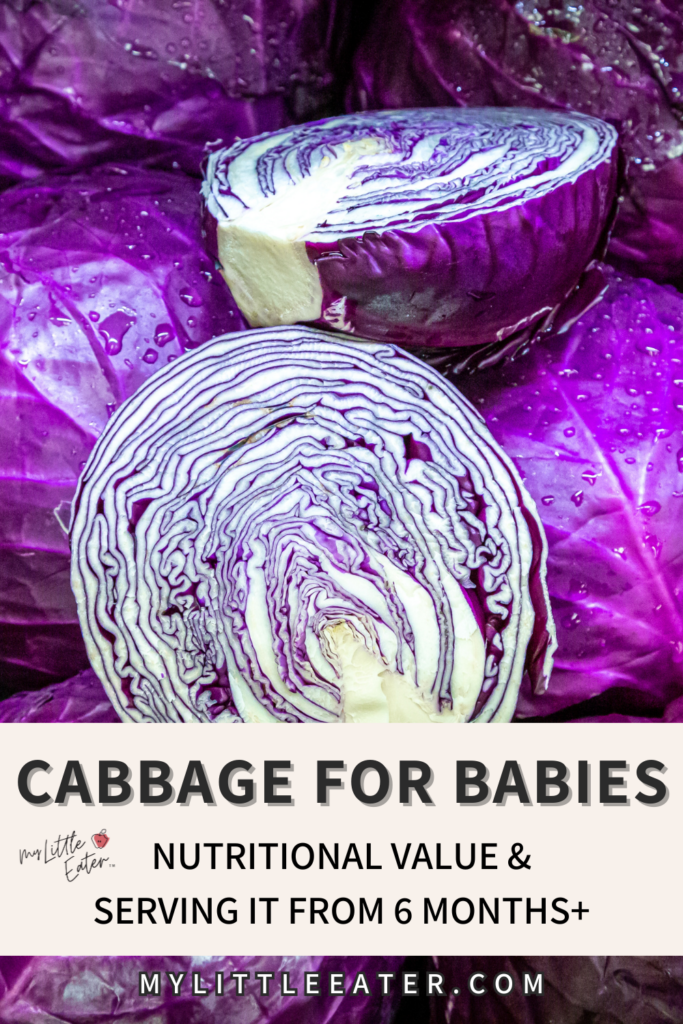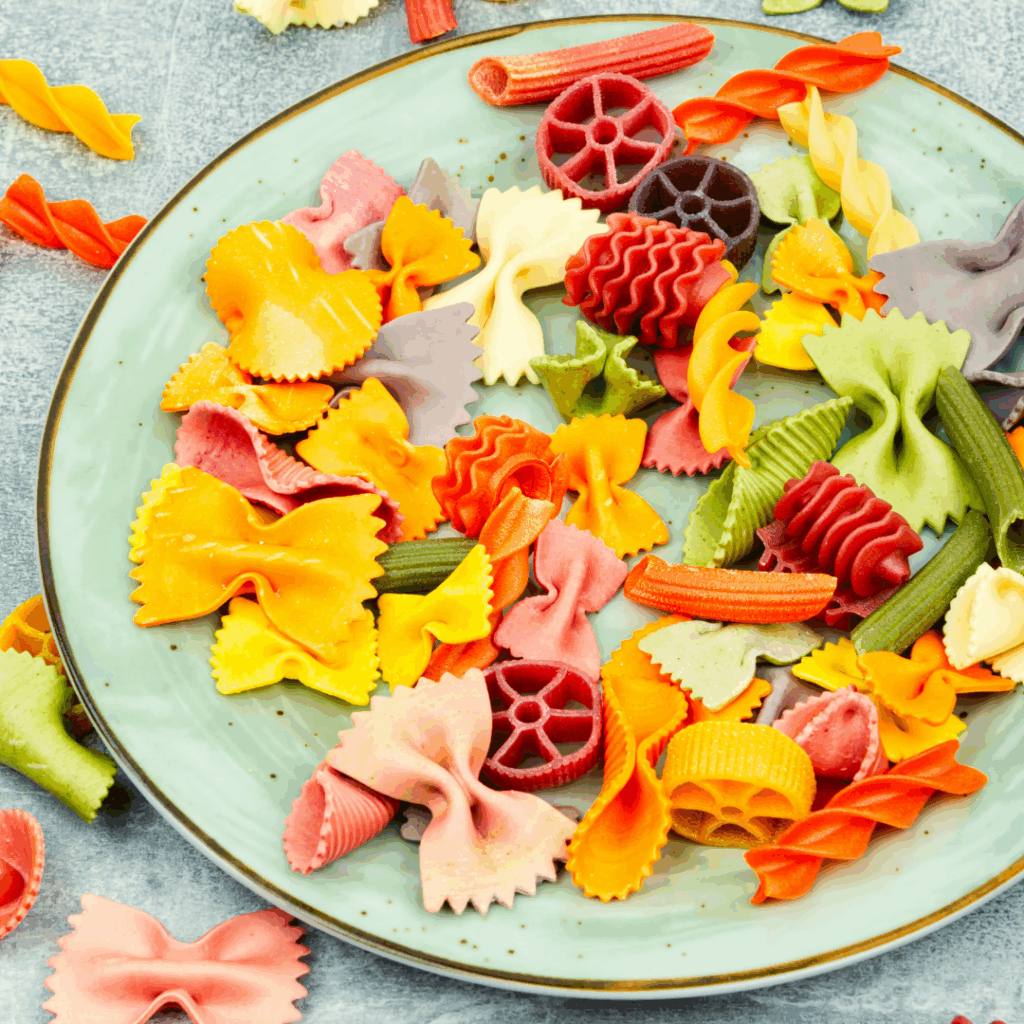Cabbage is a vegetable that is either green or purple in color. Its nutrition content varies a bit depending on the color, but cabbage is extremely nutrient-dense no matter the type! It’s packed with essential vitamins and minerals for your growing baby like folate, vitamin K, and fiber (1,2).
It’s also an excellent source of vitamin C, making it a good food to offer alongside plant-based iron sources (like tofu or beans) to help boost iron absorption (1, 2, 3)! Iron is a crucial nutrient for your growing baby and learning how to serve cabbage expands the list of high vitamin C foods you can offer to provide that added boost they need.
Table of Contents
When can babies eat cabbage?
Cabbage is safe for babies to eat beginning at around 6 months when they show all the developmental signs of being ready for solids.
Fun fact
Fun fact
Did you know that purple cabbage is a good natural food dye? Just steam purple cabbage until soft, then strain the cabbage water from the pot into a small jar.
You can then use it as a natural purple food dye in things like yogurt, birthday cake frosting, pasta… whatever you want! And don’t worry, the cabbage water is flavorless!
Is cabbage a choking hazard for babies?
Cabbage is not a common choking hazard for babies. However, the core of the cabbage is quite firm and could pose a choking risk for your baby. Minimize the risk of choking by removing the core of the cabbage and only serve soft, shredded, or minced pieces.
Always make sure you’re offering baby appropriate foods based on their skill level and ability to chew their food thoroughly.
How to choose a fresh cabbage
There are 4 varieties of cabbage; green, red (or purple), Napa, and Savoy (4). Each is unique in its own way and can be used for different types of dishes. However, you want to look for the same characteristics to determine which one is fresh.
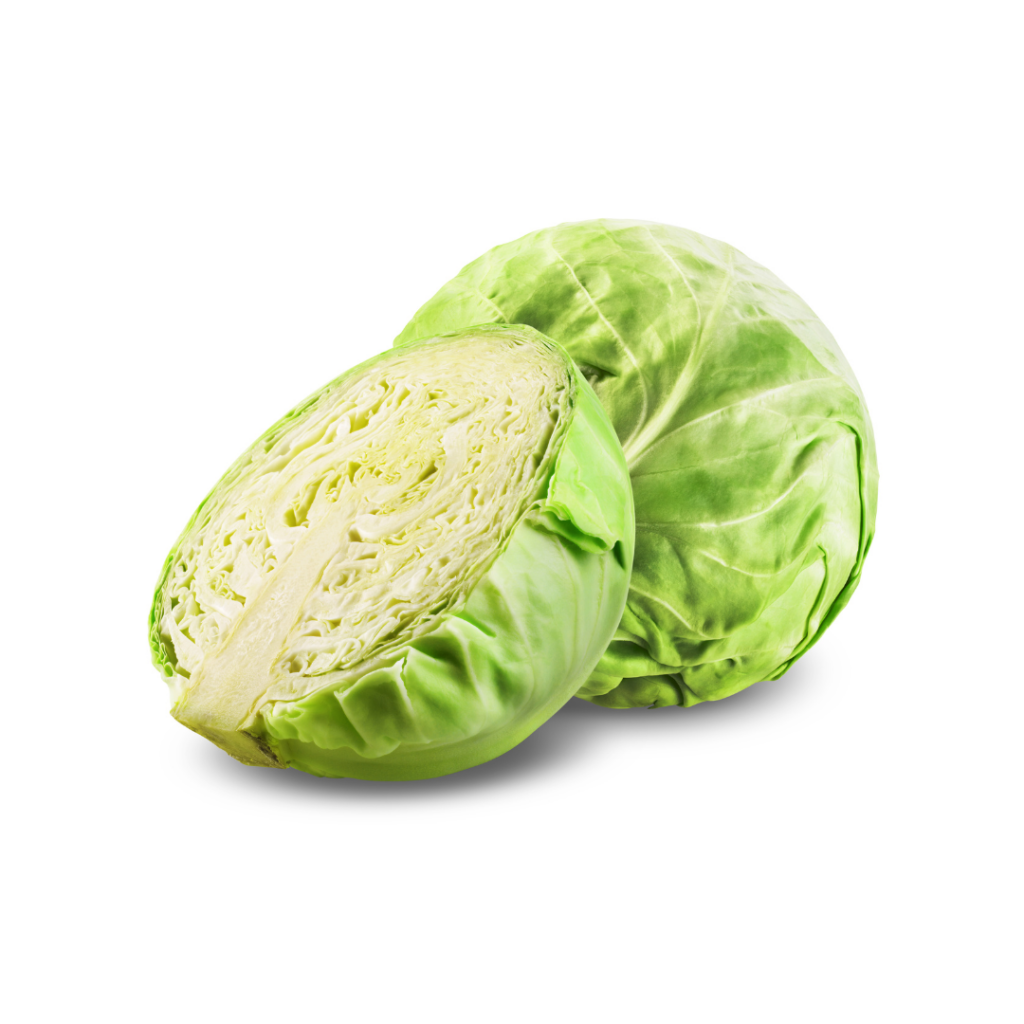
All of the cabbages, except for Savoy which has looser, more frilly leaves, are densely packed with layers of leaves (4, 5). You want to examine these closely to look for any blemishes – avoid those cabbages – and you want the leaves to have a luster or “shine” to them (4).
Finally, you want a cabbage that is heavy for its size. Pick up a few of the same size, and the heaviest one is your best choice (4).
Shopping for cabbage between November and April is best because this is typically when the most fresh cabbage is available in the grocery stores (4).
Which cabbage is best for babies?
All of the 4 varieties can be served to babies! Each has slight differences in nutrition profiles and is better suited for certain dishes over others, so let’s break that down for you.
Green cabbage: This option offers smooth leaves with a crisp texture that is perfect for salads or cooked in various dishes (4). It is one of the 2 cabbages most commonly found in grocery stores, so it’s typically a good option for convenience alone.
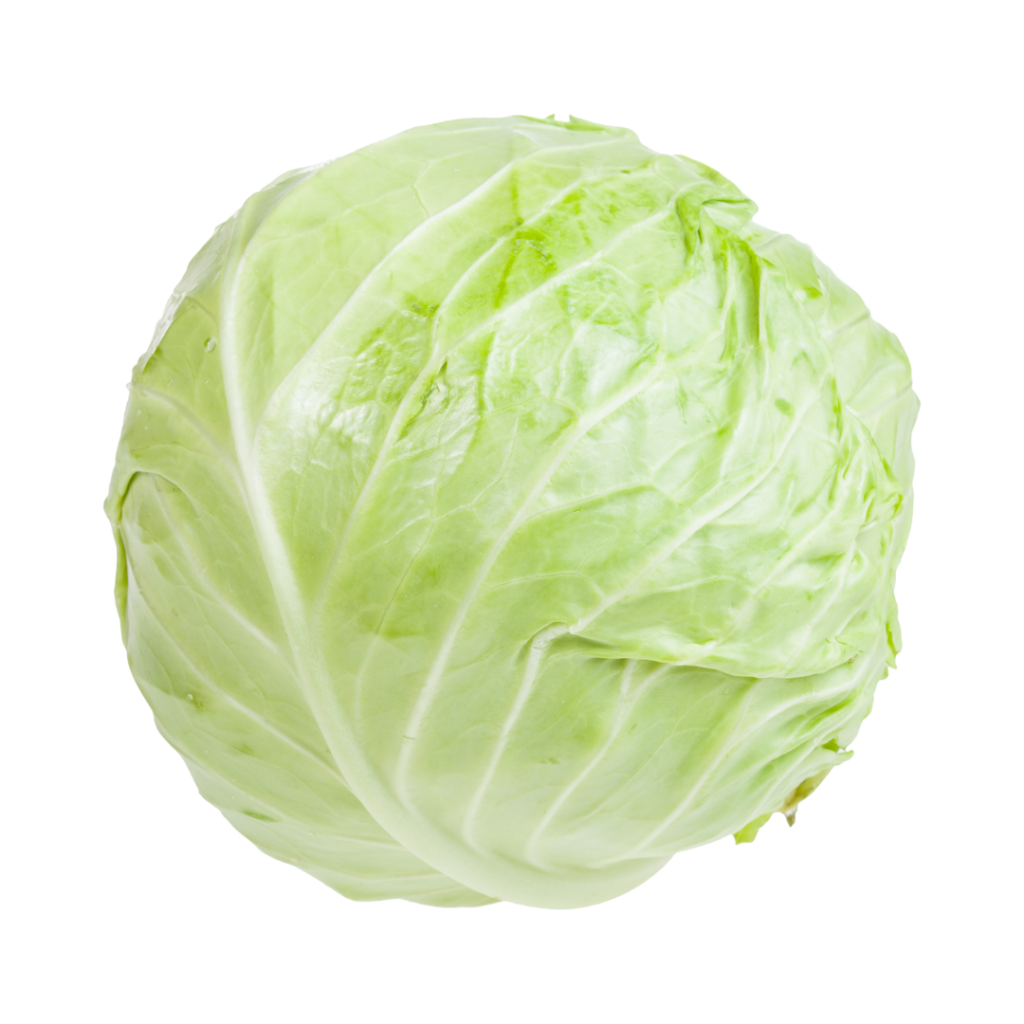
Red or purple cabbage: This is the other type that is most commonly found in grocery stores.
Just like with green cabbage, it can be served raw and cooked in various dishes (4). It is equally delicious in dishes that require slow braising and in quick-to-throw-together stir-fries.
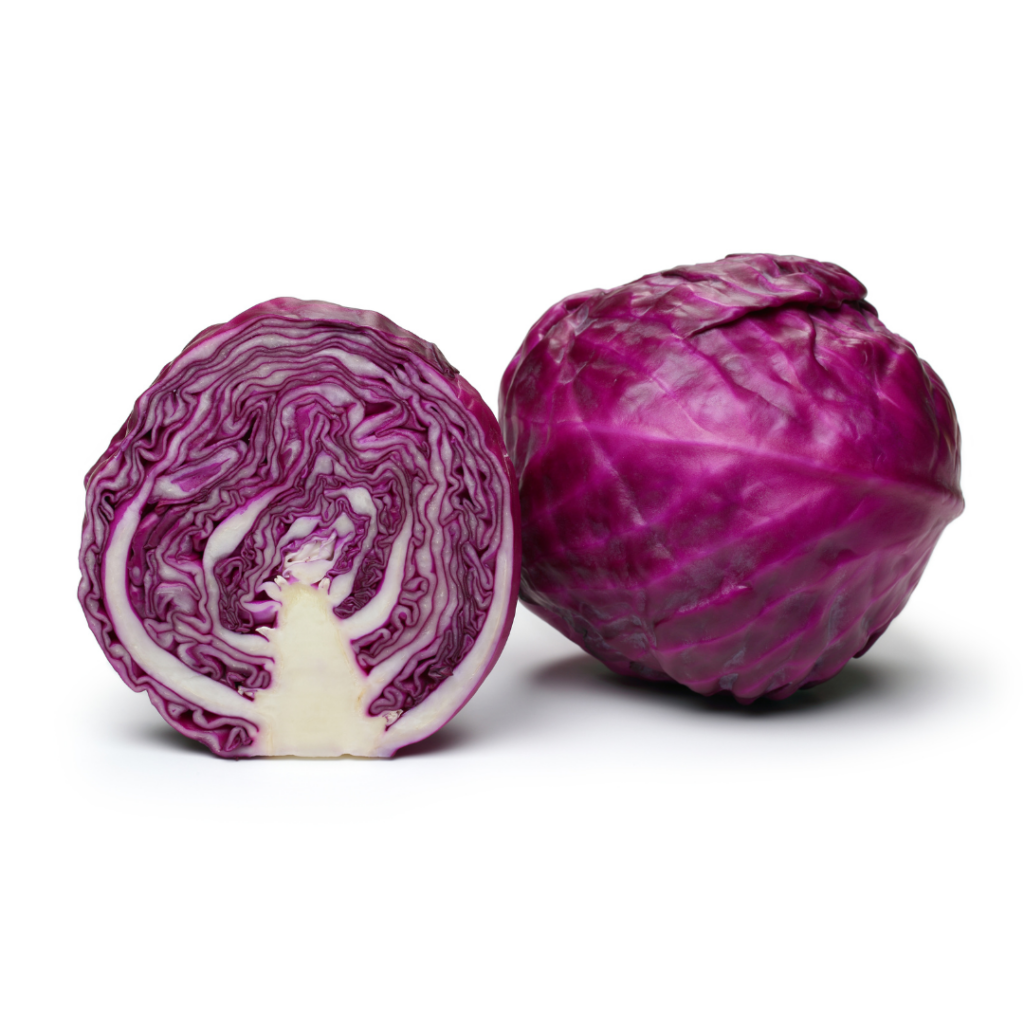
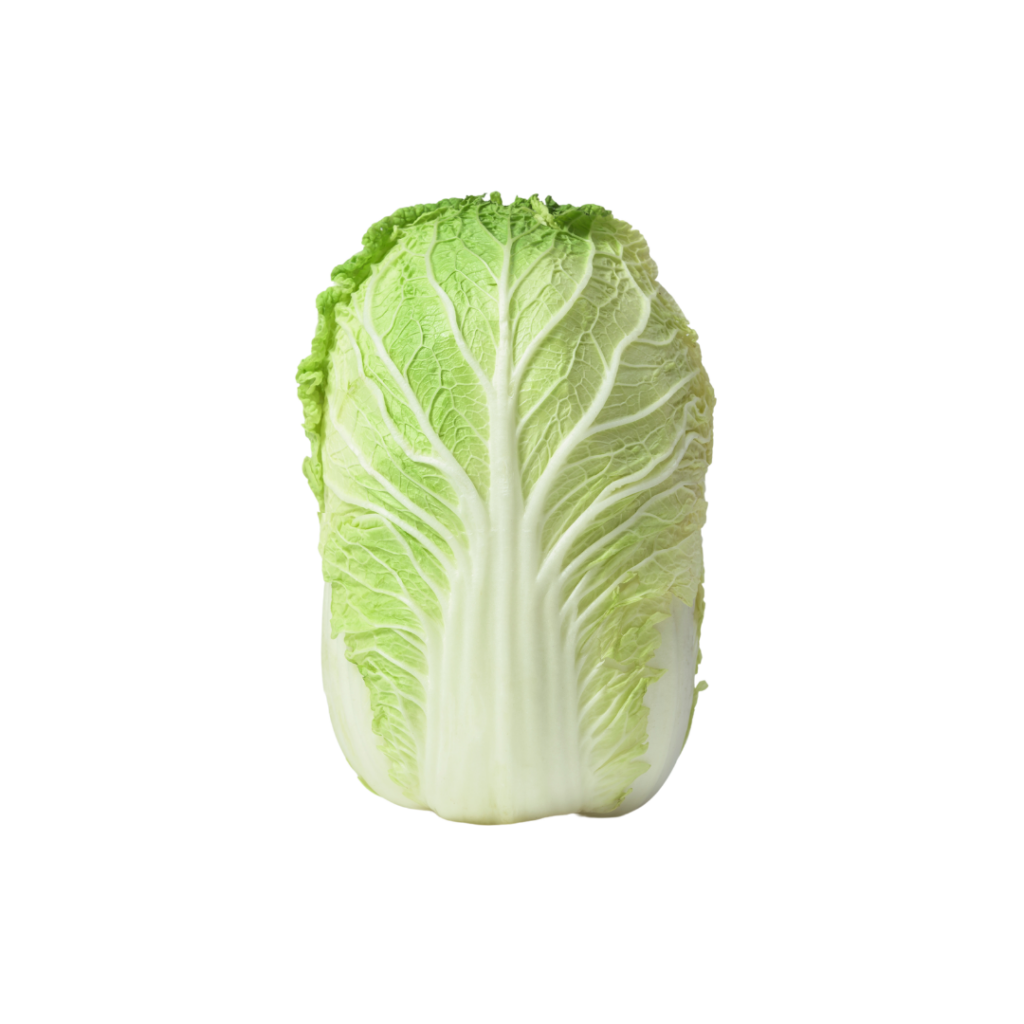
Napa cabbage: This type of cabbage is used in traditional Asian dishes and is actually the cabbage that is most often used to make Korean kimchi (4).
You can easily tell if cabbage is a Napa cabbage because instead of having the typical round shape, Napa cabbage is more of an oblong shape (4).

Savoy cabbage: This last option has a taste and texture that is more delicate than the others to match its loose, frilly leaves (4).
It can be used in many different cooked dishes, such as stuffed cabbage rolls.
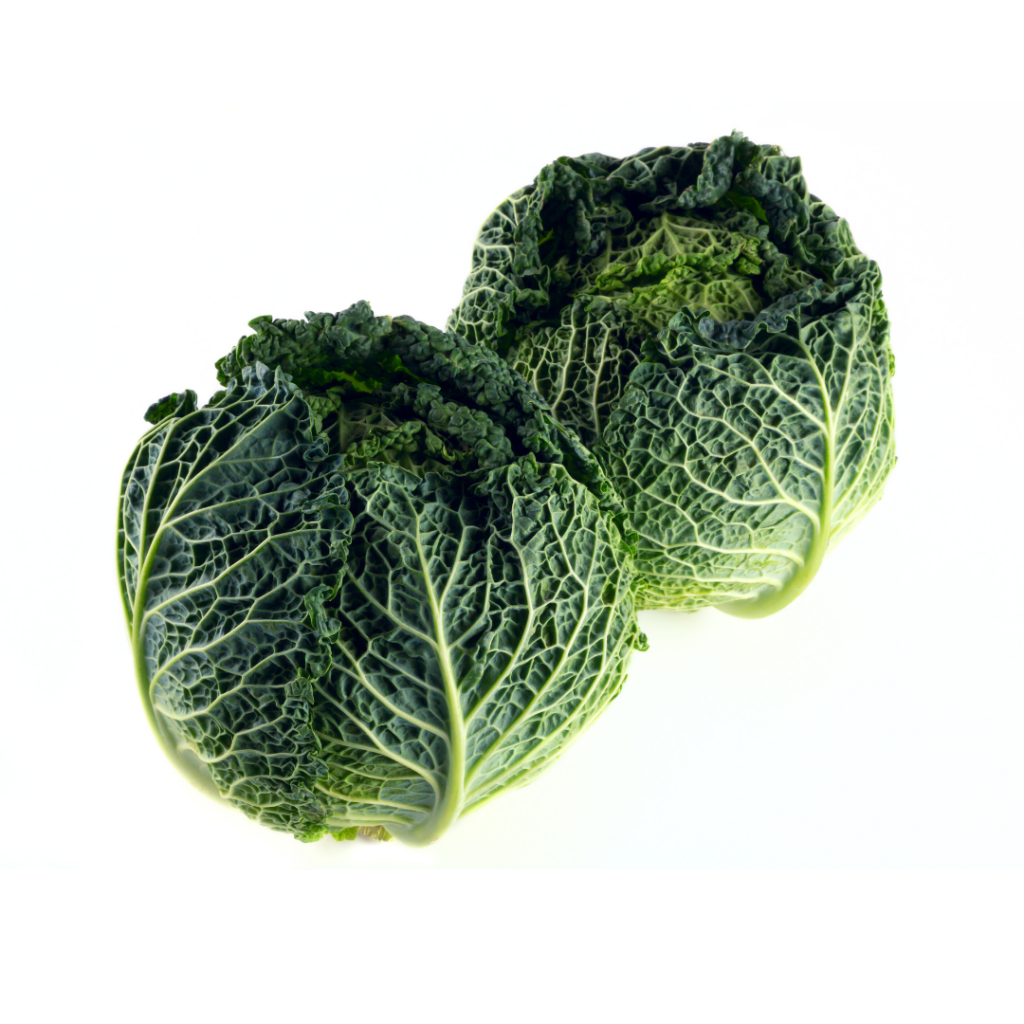
If you’re unsure, go with the option that is easily accessible to you and within your budget. All are baby-friendly and provide excellent nutritional value for your growing little one.
Do you need to buy organic cabbage for babies?
Cabbage falls on our list of produce that typically has some of the lowest levels of pesticide residue compared to other produce options. To see the full list and learn more about our recommendations when it comes to buying organic, read our blog on organic foods.
Because it falls on the list with the lowest residue, and shopping organic is typically much more expensive, we don’t see it as necessary to shop for organic cabbage. That said, we always suggest that you make these decisions based on your family values and what works best for you (because it will be different for everyone!). If you choose to shop organic – that’s great too!
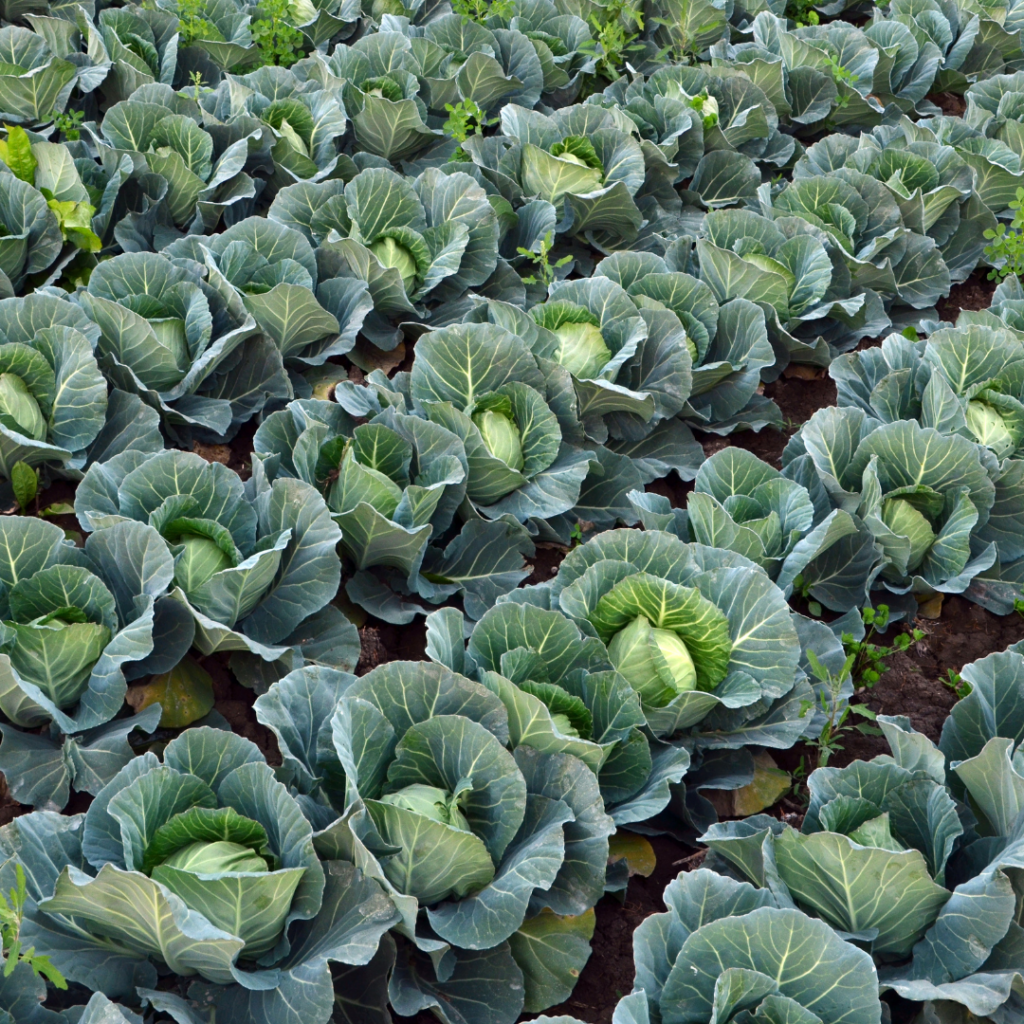
If you choose not to shop organic or are unable to, and you have concerns, there are steps you can take to minimize your baby’s pesticide exposure. Remove the outer leaves of the cabbage and thoroughly wash the remaining leaves before cutting.
You can clean them by rinsing them underwater and gently rubbing the leaves with your hands to remove any residue. It’s important to do this before cutting to ensure we aren’t transferring the residue from the outside of the cabbage to the inside of the cabbage.
How to serve cabbage according to the Texture Timeline™
These are the safest, suggested ways to serve food to your baby based on the scientific, developmental, and clinical research and expertise available to date and are vetted by pediatric doctors, speech-language pathologists, and dietitians. However, please note that babies can technically choke on anything, including purees. Always take into account your child’s individual abilities and needs and check with your doctor or feeding therapist on the safety of offering these foods to your baby. Be mindful of how to set up a safe eating environment and please know that all material, opinions, advice, and information found on mylittleeater.com is for informational and educational purposes only. See our disclaimer for more information.
What is the Texture Timeline™?
A tool exclusive to My Little Eater that allows you to start solids with your baby using purées, finger foods, or a mixture of both. We sort all foods into different phases of the timeline based on texture difficulty, presenting multiple ways to serve each food depending on what you and your baby are ready for.
You can start with any phase of the Texture Timeline™. The goal is to always be moving forward on the timeline so that you can advance your baby to more challenging textures in a timely manner. This will allow your baby to develop and practice new eating skills and ensure that they don’t stay stuck on one texture for too long.
Using the Texture Timeline™ can help to prevent picky eating, all while keeping the feeding process enjoyable and less stressful for you because you can ease into the difficult textures that often cause more anxiety and worry.
Texture Timeline Phase 0
Option 1: Raw strips (Palmar Grasp)

Large, thick strips of raw cabbage make for a good, highly resistive, whole food for your baby to gnaw on before they have teeth and the ability to take bites. It’s a great way for your baby to begin exploring the boundaries of their mouth and get exposure to a new flavor and texture with a very low risk of choking.
Once your baby has developed the ability to bite and/or break off chunks, especially with teeth, raw cabbage strips should no longer be offered.
Step 1: Place a washed cabbage onto a cutting board, then use a sharp knife to remove the thick stem at the bottom.
Step 2: Use a sharp knife to cut the cabbage in half, lengthwise. Place both halves face down onto your cutting board.
Step 3: Take one of the cabbage halves and make a lengthwise cut about 1-2 inches in width. Cabbage naturally has layers, some layers being thicker than others – separate one of the thick layers from the portion that you cut (look for one that’s about ½ inch thick). Cut the thick strip in half so that you have two strips about 1-2 inches wide and 3 inches long. You’ll be left with strips that your baby can easily hold onto and munch on.
Step 4: Serve the large, thick strips of raw cabbage to your baby for them to grab and hold using their palmar grasp.
Tip: You can also freeze raw cabbage strips for extra resistiveness and for a cooling effect on those little gums during teething.
Texture Timeline Phase 0
Option 2: Thin purée (Utensil)
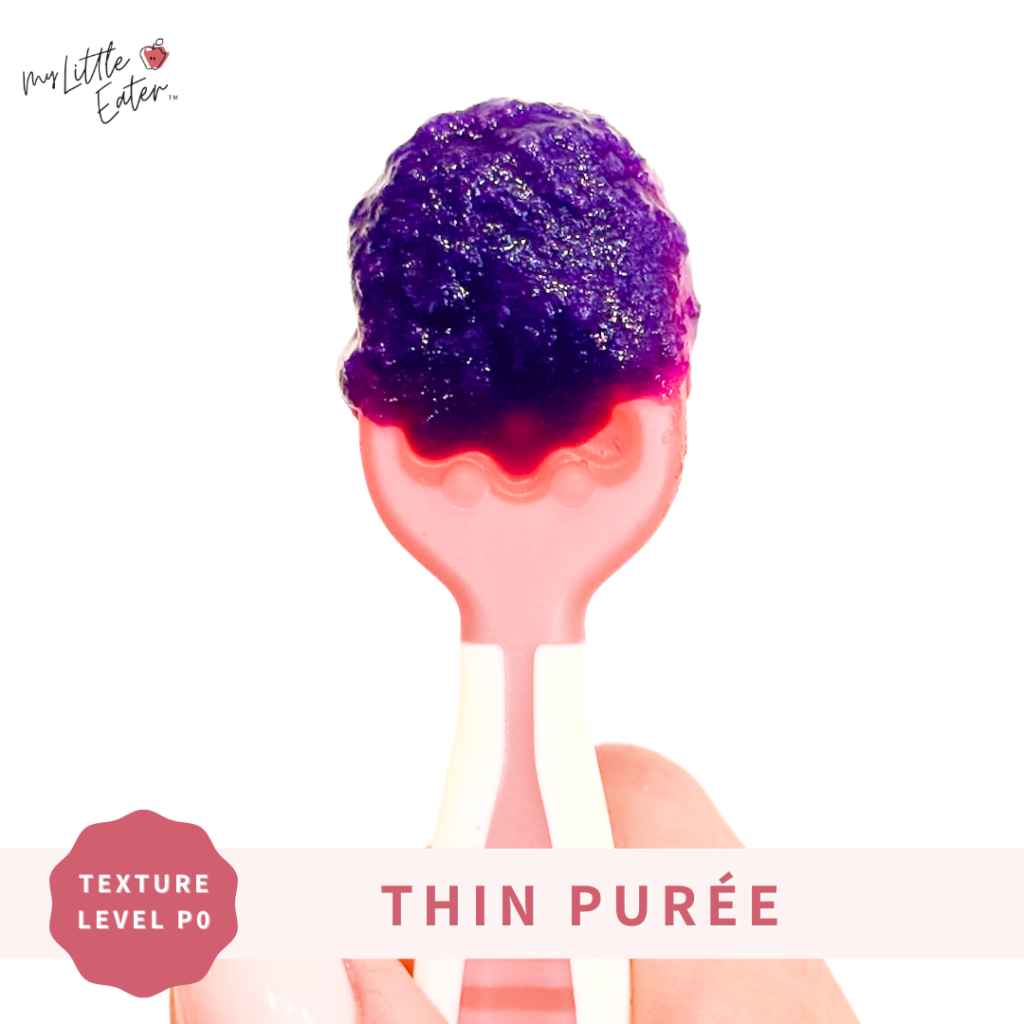
Cook cabbage until soft, blend it along with a bit of water, breastmilk, or formula until you have a thin, smooth purée. Serve to your baby on a preloaded spoon.
Texture Timeline Phase 2
Shredded (cooked), mixed into a purée (Utensil)

Cook shredded cabbage until soft, then mix it into a binding purée like hummus or mashed potatoes. Serve to your baby on a preloaded spoon. Or, if they aren’t interested in using a spoon, you can let them dig in with their hands!
Texture Timeline Phase 3
Shredded (cooked) (Utensil/Pincer Grasp)

Cook shredded cabbage until soft, then serve to your baby on a preloaded spoon. Alternatively, you can dump a small pile of shredded cabbage onto your baby’s tray and allow them to practice picking up the shredded cabbage using their pincer grasp.
Storing tips for raw & cooked cabbage
Whole cabbage can be stored in your fridge for up to 2 months (or sometimes even more!) (6). It’s recommended not to wash your cabbage before storing it because this will shorten how long it can stay fresh, causing it to rot more quickly (5, 6).
That said, we don’t recommend cutting into a cabbage without washing it first to avoid transferring anything from the outside to the inside of the cabbage.
In this case, we would either recommend cooking all of it and storing the cooked leftovers in the freezer to last longer, or washing it, cutting it, and using the leftovers more quickly before it goes bad in the fridge. Cabbage heads that have already been cut and wrapped in plastic will last in the fridge for several weeks (5).
If you’re looking to buy something that will last a long time, red or green cabbages last the longest. Savoy is slightly less durable but will still stay fresh for a few weeks in the fridge (4).
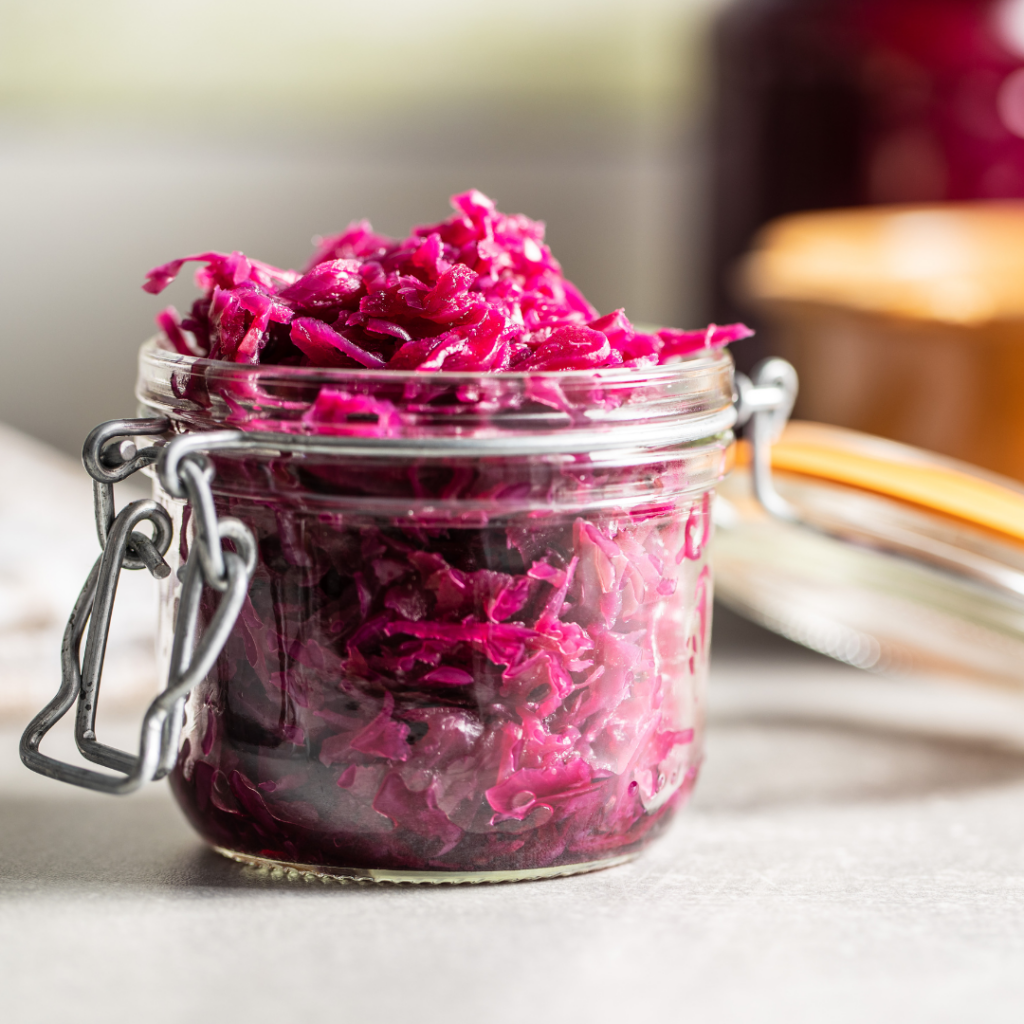
Once the cabbage has been cooked, it can be stored in an airtight container in the fridge for 3-5 days and in the freezer for 10-12 months (7). If the cooked cabbage is part of other cabbage recipes, such as cabbage rolls or stir fry, it will only last in the fridge for 3-4 days (7).
Nutritional benefits
Cabbage is filled with essential nutrients that babies need to grow and thrive! They’re especially high in vitamin K which can help to support bone health and normal blood clotting (2,8).
Green cabbage also contains a surprising amount of vitamin C at 28mg per half-cup serving – that’s over half of your baby’s daily recommended vitamin C intake (9)! Vitamin C can benefit immune health and help with iron absorption from plant-based sources (2,10,11).
Learn more about the importance of iron for babies.
Purple cabbage is rich in anthocyanins which are responsible for its vibrant purple color (16). Anthocyanins act as an antioxidant in the body to help protect cells from damage (17).
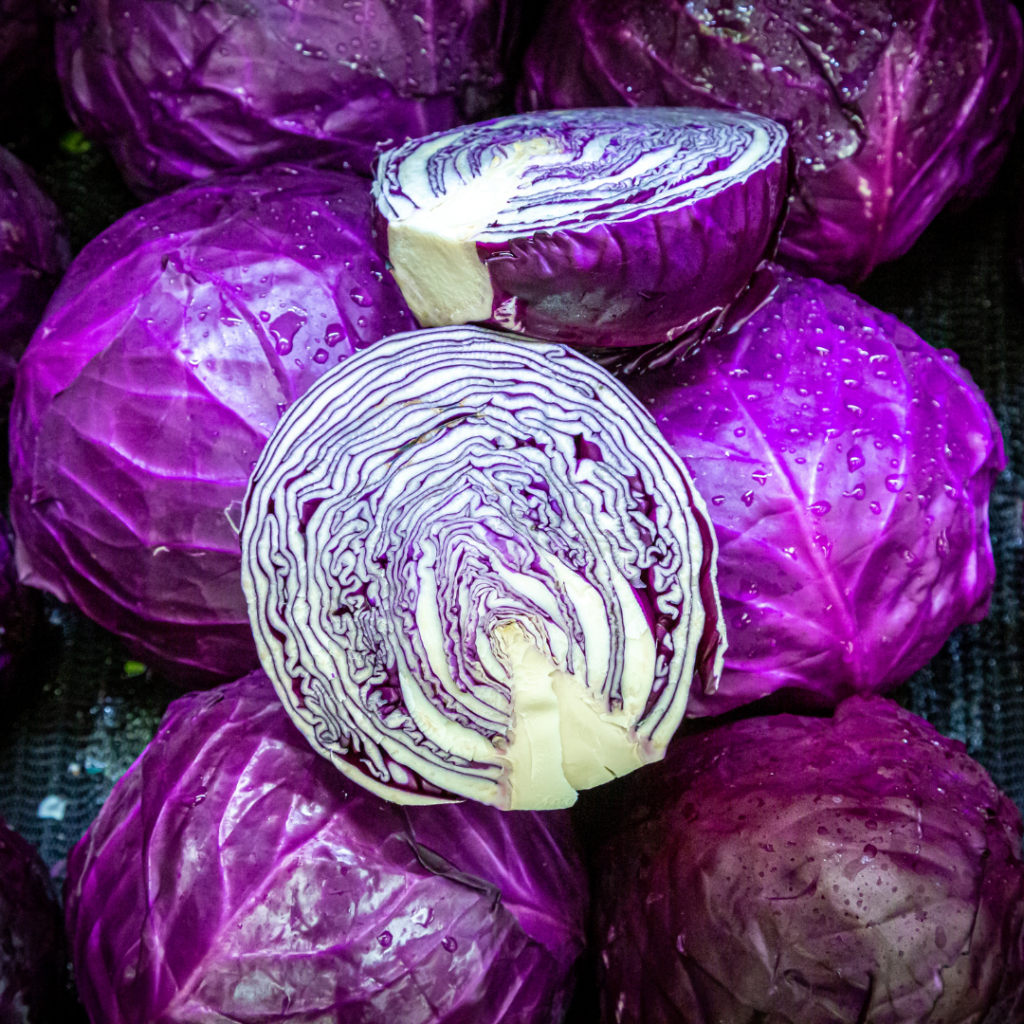
Other nutrients found in cabbage include:
- Fiber: supports healthy digestion and prevents constipation (2,12).
- Vitamin A: supports immune function and eye health (2,13,14).
- Folate: plays a role in the formation of healthy red blood cells (2,14).
- Vitamin B6: supports brain development, the production of red blood cells, and the metabolism of carbohydrates, protein, and fat (2,15).
Can babies be allergic to cabbage?
Cabbage is not considered to be a top allergenic food for babies. It can be introduced alongside other foods without having to wait (the 2-day wait rule is for top allergens only).
Although a cabbage allergy is rare, it’s not impossible. Cabbage can trigger an allergic reaction called oral allergy syndrome (OAS), commonly called Pollen Food Allergy Syndrome (PFAS). This type of allergy is most likely to occur in those who are allergic to mugwort pollen, as the proteins in cabbage are similar to proteins found in this type of pollen (18, 19).

With OAS, the body’s immune system confuses the similar proteins in food for the ones found in pollen and therefore reacts to the proteins as an allergen. OAS is considered to be a mild food allergy with common symptoms being itchiness or swelling of the mouth, face, lips, tongue, or throat (20). Symptoms usually occur within a few minutes but can appear up to an hour after eating (20).
Cabbage FAQs
Can babies eat sauerkraut?
Sauerkraut is slightly higher in sodium than other food options you may serve your baby, however, it is still safe to offer. We actually love introducing this food as a way to offer a new flavor that is unique and not found in many foods. This helps to expand their palate and reduce the risk of picky eating later on.
That said, be sure to balance out the meal with low-sodium options, and consider what else is being served that day too. You can also balance out their sodium intake over the course of a week.
Keep in mind that the benefits of introducing the new flavor and texture outweigh the risks of offering a food slightly higher in sodium like this one – so don’t worry too much!
Can babies eat kimchi?
We recommend waiting until your baby is at least 12 months old and they’ve had a lot of experience with various textures before serving kimchi. This is because it can be more crunchy in texture making it more difficult to chew.
With more practice, they should be able to handle it after their first birthday, but if you’re at all concerned about their chewing abilities it’s ok to hold off a bit longer – you know your baby best!
Additionally, it is a high-salt food, so we also want to be conscious of that and be sure to balance out their diet with low-sodium options for their other meals that day and in the days following eating kimchi.
To get full access to our Texture Timeline™ Food Video Library so you can search any food and find out important nutrition and allergy info, plus how to safely serve it, check out our Baby Led Feeding Program.
In addition to getting lifetime access to all of our video teachings and printable resources for starting solids so you can feed your baby with confidence, you’ll also get lifetime access to the video library and ongoing support from the My Little Eater team!
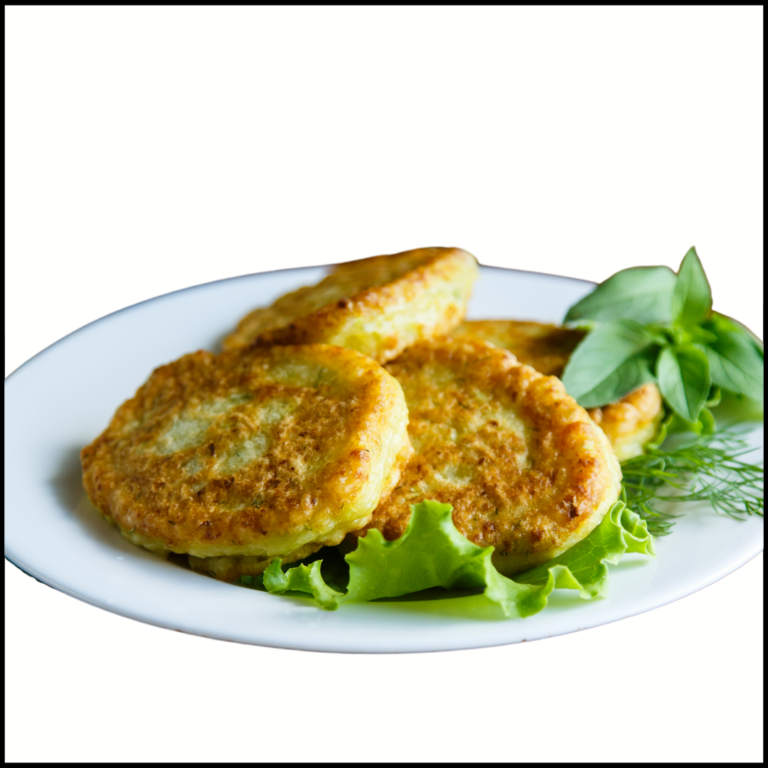
Cabbage Pancakes
Equipment
- 1 mixing bowl (large)
- 1 frying pan (medium)
Ingredients
- 1 tbsp oil (olive, avocado, etc.)
- ⅛ cup dill (finely chopped)
- ¼ cup all-purpose flour
- 2 eggs
- 8 oz. shredded green cabbage
- salt to taste (can omit for babies)
Instructions
- Combine cabbage, dill, eggs, and salt (optional) in the mixing bowl, stir well.
- Add the flour and continue to stir.
- Heat the oil in a non-stick frying pan over medium heat, add the mixture to the pan.
- Flatten the mixture with a spoon until it is about 3/4 - 1 inch thick. Cover the pancake with a lid and cook for about 5 - 7 minutes.
- Flip the pancake and cook for another 5 - 7 minutes.
- Remove from the heat, let cool, and cut into strips for your baby to eat with their palmar grasp.
Notes
- Ensure that the pancake cooks well enough to cook the egg thoroughly and soften the cabbage enough that it is safe for your baby to eat.
- Test a piece yourself before offering it to your baby to ensure it passes the squish test (gently squish it between your thumb and forefinger to mimic baby's gums).
- If you're concerned, try cooking it at a slightly lower temperature for a longer period of time, covered, to help the cabbage soften even more.
- Don't shy away from the fresh herbs in this recipe! It is safe for your baby to have herbs and spices from day one of starting solids.
- Try out other flavor combinations as well - garlic powder, onion powder, pepper, ground mustard, turmeric, etc. are some spices that may pair well with cabbage.
Was this helpful? Pin it for later!
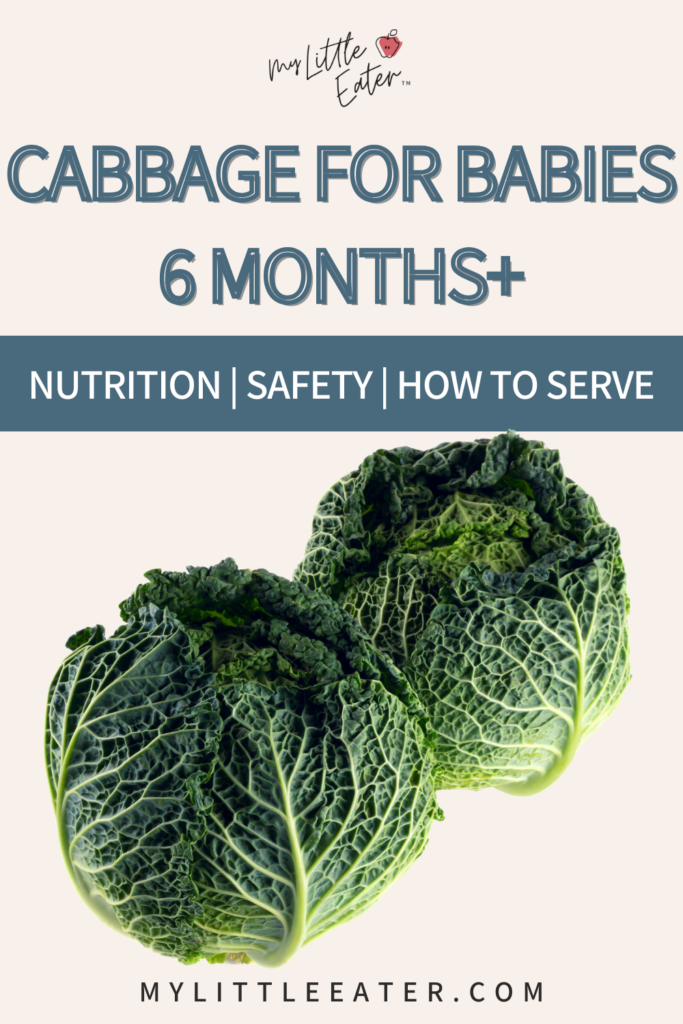
References
- U.S. Department of Agriculture. (2019). Cabbage, common, cooked, boiled, drained, with salt. https://fdc.nal.usda.gov/food-details/168514/nutrients
- U.S. Department of Agriculture. (2019). Cabbage, red, cooked, boiled, drained, with salt. https://fdc.nal.usda.gov/food-details/168515/nutrients
- Cook, J., & Reddy, M. (2001). Effect of ascorbic acid intake on nonheme-iron absorption from a complete diet. The American journal of clinical nutrition. 73. 93-8. DOI: 10.1093/ajcn/73.1.93.
- https://www.allrecipes.com/article/its-all-about-that-cabbage/
- https://foodprint.org/real-food/cabbage/
- https://www.allrecipes.com/article/how-long-does-cabbage-last/#:~:text=Cabbage%20is%20best%20stored%20whole,months%20when%20stored%20this%20way.
- https://www.unlockfood.ca/en/Articles/Budget/All-About-Cabbage.aspx
- American Academy of Allergy Asthma & Immunology. (2024). Oral Allergy Syndrome (OAS). https://www.aaaai.org/tools-for-the-public/conditions-library/allergies/oral-allergy-syndrome-(oas)
- Palacín, A., Cumplido, J., Figueroa, J., Ahrazem, O., Sánchez-Monge, R., Carrillo, T., Salcedo, G., & Blanco, C. (2006). Cabbage lipid transfer protein Bra o 3 is a major allergen responsible for cross-reactivity between plant foods and pollens.
- Kelava, N., Lugović-Mihić, L., Duvancić, T., Romić, R., & Situm, M. (2014). Oral allergy syndrome–the need of a multidisciplinary approach. Acta clinica Croatica, 53(2), 210–219The Journal of allergy and clinical immunology, 117(6), 1423–1429. https://doi.org/10.1016/j.jaci.2006.01.026
- Institute of Medicine (US) Panel on Micronutrients. (2001). Dietary Reference Intakes for Vitamin A, Vitamin K, Arsenic, Boron, Chromium, Copper, Iodine, Iron, Manganese, Molybdenum, Nickel, Silicon, Vanadium, and Zinc. National Academies Press (US).
- Government of Canada. (2023). Dietary reference intakes tables: Reference values for vitamins: reference values for vitamin C, thiamine, riboflavin, niacin, and vitamin B6. https://www.canada.ca/en/health-canada/services/food-nutrition/healthy-eating/dietary-reference-intakes/tables/reference-values-vitamins.html
- Cook, J., & Reddy, M. (2001). Effect of ascorbic acid intake on nonheme-iron absorption from a complete diet. The American journal of clinical nutrition. 73. 93-8. DOI: 10.1093/ajcn/73.1.93.
- Jacob, R. A., & Sotoudeh, G. (2002). Vitamin C function and status in chronic disease. Nutrition in clinical care : an official publication of Tufts University, 5(2), 66–74. https://doi.org/10.1046/j.1523-5408.2002.00005.x
- Brownawell, A.M., Caers, W., Gibson, G.R., Kendall, C.W.C., Lewis, K.D., Ringel, Y., & Slavin, J.L. (2012). Prebiotics and the Health Benefits of Fiber: Current Regulatory Status, Future Research, and Goals. The Journal of Nutrition, 142(5), 962-974. https://doi.org/10.3945/jn.112.158147
- Noh, M. F. M., & Mustar, R. D. N. G. (2019). Vitamin A in health and disease. Vitamin A.
- Ross, A. C., Caballero, B. H., Cousins, R. J., Tucker, K. L., & Ziegler, T. R. (2012). Modern nutrition in health and disease: Eleventh edition. Wolters Kluwer Health Adis (ESP).
- Mackey, A., Davis, S., & Gregory, J. (2006). Vitamin B6. Modern Nutrition in Health and Disease. Lippincott Williams and Wilkins, 194-210
- Drăghici, G.A., Lupu, M., Borozan, A.B., Nica, D.V., Alda, S., Alda, L.M., Gogoaşă, I., Gergen, I.I., & Bordean, D.M. (2013). Red cabbage, millennium’s functional food. Journal of Horticulture, Forestry and Biotechnology, 17, 52-55.
- Lu, W., Shi, Y., Wang, R., Su, D., Tang, M., Liu, Y., & Li, Z. (2021). Antioxidant Activity and Healthy Benefits of Natural Pigments in Fruits: A Review. International journal of molecular sciences, 22(9), 4945. https://doi.org/10.3390/ijms22094945

Bianca Gruenewald, RD
Bianca is a Registered Dietitian and works in a client support role at My Little Eater Inc. She's a proud auntie to her three year old niece and four year old nephew!

Bianca Gruenewald, RD
Bianca is a Registered Dietitian and works in a client support role at My Little Eater Inc. She's a proud auntie to her three year old niece and four year old nephew!

Mallory Roberts, SLP
Mallory is a Speech-Language Pathologist, Infant Feeding Specialist, and Craniosacral Therapist. She's also a busy mom of four little ones!

Mallory Roberts, SLP
Mallory is a Speech-Language Pathologist, Infant Feeding Specialist, and Craniosacral Therapist. She's also a busy mom of four little ones!
